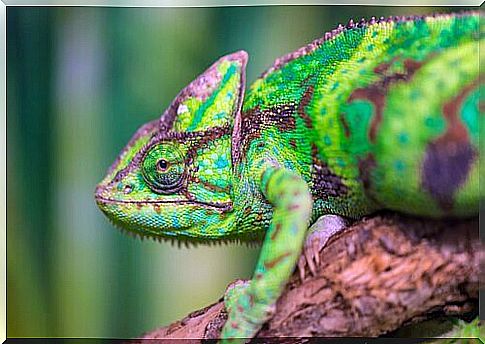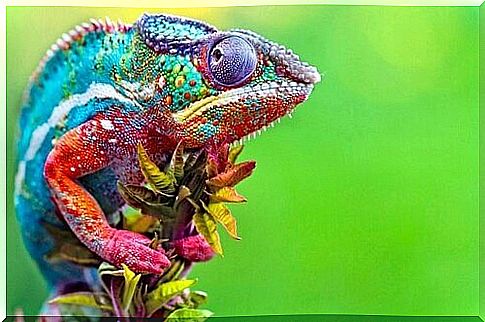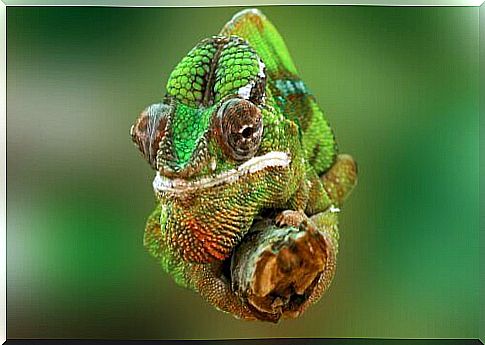Chameleon Camouflage: How Does It Change Color?

The chameleon is one of the most curious and fascinating animals there is. On the one hand, it hunts insects with its long, sticky tongue and, on the other, uses its bright colors to hide in the environment around it. Would you like to know all the secrets of the famous chameleon mimicry ? So, read on!
The big eyes of this little reptile move in different directions and independently. But the real show is admiring its ability to change color.
For a long time it was thought that this ability only responded to the need to blend in to avoid the dangers to which it was exposed. However, some scientific studies reveal that chameleon mimicry is due to other reasons as well. And, in a few lines, we will know together what they are.
How does the chameleon change color?
This scaly reptile has the ability to change the pigmentation of its skin, based on the light and colors of the environment. It also does this due to other internal physical factors. It is possible that you create very showy fantasies or, on the contrary, try to go unnoticed.
The innate ability to blend in, along with the ability to show eye-catching colors, is due to his physical condition. But then: what is the natural color of the chameleon?
Under its many layers of skin, this animal has several pigmented cells, which are like small crystals. They are formed by chromatophores, iridophores, guanophores, melanophores, erythrophores, cyanophores, leucophores and xanthophores.

Each of these groups of cells is responsible for “reproducing” a different color. And it does so depending on the light reflecting on the chameleon’s body, but also on the basis of body and ambient temperature.
These highly specialized cells are able to regulate the distribution of the pigments they incorporate. The visible result is a great variety of reflections, shades and patterns.
Why does the chameleon change color?
The first thing that needs to be clarified is that the chameleon’s color change doesn’t just respond to the need to blend in. This idea, although widespread, has now been disproved.
It is true that these reptiles have an impressive ability to mimic their environment, but the fact that they decide to change color can be motivated by other reasons as well.
Chameleons have the ability to adopt the colors of leaves, branches and, in general, of the vegetation that surrounds them. When they are immersed in nature, distinguishing them from their surroundings is almost impossible.
The chameleon’s mimicry can respond to its need to hide from predators that haunt it, especially at nightfall. The reason for mimicking the environment may be due to the desire to go unnoticed by their prey, or even to hunt more easily.

Other motifs of the chameleon mimicry
In addition to the above, most of the time the chameleon’s color changes are due to the physical condition of its body. Or even, according to many experts, to his emotions.
One of the most frequent situations of color change is the courtship process of the male to the female, before mating. On these occasions, the male chameleon becomes a real rainbow of colors, very lively and bright, to attract the future partner.
The change in color can also be related to the weather. The animal can adapt its body, through colors, to regulate its temperature, to better resist cold, heat, wind or sun.
Finally, many scientific studies have revealed that the mood of these reptiles, as well as psychological factors, also play an important role in the color of their skin. In this way, each shade can be translated into a different emotion : readiness, fear, stress, courtship, relaxation, etc.
The change in color of the chameleon plays a very important role in communication. During a fight, chameleons are able to know their opponent’s mood and exploit that information. Not surprisingly, they will know if their opponent is furious, scared, etc.
Not all chameleons change color
It is important to note that, contrary to popular belief, not all chameleons have this camouflage ability. Only some species can do this.
For example, female chameleons and their young cannot change color. The reason for this inability to blend in is that they do not have iridophore crystals under the skin.









